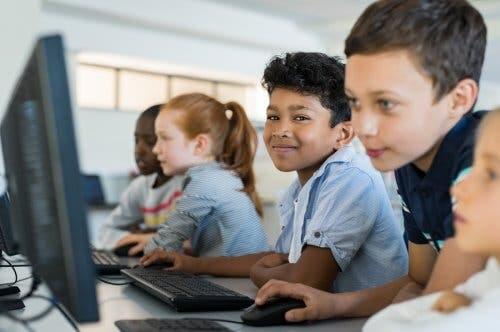The Computer Corner in the Classroom

The computer corner in the classroom is an innovative educational technique that lets you use new technology in an educational and fun way. Then, kids feel motivated to learn and understand that computers are great tools to investigate, search for information and learn new things.
“The emergence of new technologies forces us to educate children differently.”
– Howard Gardner –
The computer corner in the classroom
The computer corner is a way to enrich your curriculum by having a space in the classrooms for computers. Here, kids can carry out tasks based on the WebQuest work model.
In this way, there are attractive and research-oriented activities that kids must solve using mainly information on the web. This task, according to Bernie Dodge and Tom March, should involve more than just answering questions, or repeating what they see on the screen.
In other words, teachers need to make a WebQuest that focuses on achieving a clear and specific goal. Then, kids have to do a series of structured activities so they build the knowledge they need to do the task.

So, the computer corner can be a way to carry out different kinds of computer-based activities:
- Group: Small groups or pairs use a computer. Then, they use teamwork to solve the tasks.
- Individual: Each student sits in front of a computer and uses it on their own to do the activities.
- Guided: Children work on the computer under the direction and supervision of the teacher, doing the task.
- Free: Kids use the computers freely. Then, they can experiment with it and make their own decisions.
Implications of using the computer corner
Having a computer corner in class implies modifying the role of teachers and students in the learning process. In fact, it helps kids learn autonomously, putting them in charge of their own learning.
Meanwhile, teachers must assume the role of counselors, research facilitators, motivational figures, etc. It also affects the use of space and time in the classroom, since you’ll need computers and internet. Additionally, homework needs to be organized and done within the school day.
“Technology is just a tool. In terms of getting the kids working together and motivating them, the teacher is most important.”
– Bill Gates –
Benefits of using technology in the classroom
Computers in the classroom provide multiple benefits for student education, such as:
- Develop research strategies and information processing.
- Encourage creativity. Computers make it possible to think of different solutions to get to the final solution.

- Learn to experiment and use information.
- Respect the learning rhythm of all students.
- Promote socialization.
- Promote a spirit of inquiry and curiosity.
- Encourage collaboration, cooperation and discussion among classmates.
Also, this way of working helps develop these basic learning competencies:
- Linguistic communication.
- Digital information processing.
- Learning how to learn.
- Personal autonomy.
- Social and civic skills.
For these reasons, the computer corner is a good option to have in the classroom. It’s motivating, and a different way of working and learning new things.
“We need technology in every classroom and in every student and teacher’s hand, because it is the pen and paper of our time, and it is the lens through which we experience much of our world.”
– David Warlick –
The computer corner in the classroom is an innovative educational technique that lets you use new technology in an educational and fun way. Then, kids feel motivated to learn and understand that computers are great tools to investigate, search for information and learn new things.
“The emergence of new technologies forces us to educate children differently.”
– Howard Gardner –
The computer corner in the classroom
The computer corner is a way to enrich your curriculum by having a space in the classrooms for computers. Here, kids can carry out tasks based on the WebQuest work model.
In this way, there are attractive and research-oriented activities that kids must solve using mainly information on the web. This task, according to Bernie Dodge and Tom March, should involve more than just answering questions, or repeating what they see on the screen.
In other words, teachers need to make a WebQuest that focuses on achieving a clear and specific goal. Then, kids have to do a series of structured activities so they build the knowledge they need to do the task.

So, the computer corner can be a way to carry out different kinds of computer-based activities:
- Group: Small groups or pairs use a computer. Then, they use teamwork to solve the tasks.
- Individual: Each student sits in front of a computer and uses it on their own to do the activities.
- Guided: Children work on the computer under the direction and supervision of the teacher, doing the task.
- Free: Kids use the computers freely. Then, they can experiment with it and make their own decisions.
Implications of using the computer corner
Having a computer corner in class implies modifying the role of teachers and students in the learning process. In fact, it helps kids learn autonomously, putting them in charge of their own learning.
Meanwhile, teachers must assume the role of counselors, research facilitators, motivational figures, etc. It also affects the use of space and time in the classroom, since you’ll need computers and internet. Additionally, homework needs to be organized and done within the school day.
“Technology is just a tool. In terms of getting the kids working together and motivating them, the teacher is most important.”
– Bill Gates –
Benefits of using technology in the classroom
Computers in the classroom provide multiple benefits for student education, such as:
- Develop research strategies and information processing.
- Encourage creativity. Computers make it possible to think of different solutions to get to the final solution.

- Learn to experiment and use information.
- Respect the learning rhythm of all students.
- Promote socialization.
- Promote a spirit of inquiry and curiosity.
- Encourage collaboration, cooperation and discussion among classmates.
Also, this way of working helps develop these basic learning competencies:
- Linguistic communication.
- Digital information processing.
- Learning how to learn.
- Personal autonomy.
- Social and civic skills.
For these reasons, the computer corner is a good option to have in the classroom. It’s motivating, and a different way of working and learning new things.
“We need technology in every classroom and in every student and teacher’s hand, because it is the pen and paper of our time, and it is the lens through which we experience much of our world.”
– David Warlick –
All cited sources were thoroughly reviewed by our team to ensure their quality, reliability, currency, and validity. The bibliography of this article was considered reliable and of academic or scientific accuracy.
- Cobo, C., Eguren, J., Fernández, S., Galende, I., González, M.I., Armendáriz, J.M, Pérez, M. M. y Puertas, M. L. (2014). Enriquecimiento curricular. País Vasco: Servicio de Imprenta y Reprografía del Gobierno Vasco.
- Morón-Macías, M. C. (2010). Una herramienta para aprender: el ordenador en las aulas de educación infantil. Revista digital para profesionales de la enseñanza (9).
This text is provided for informational purposes only and does not replace consultation with a professional. If in doubt, consult your specialist.








